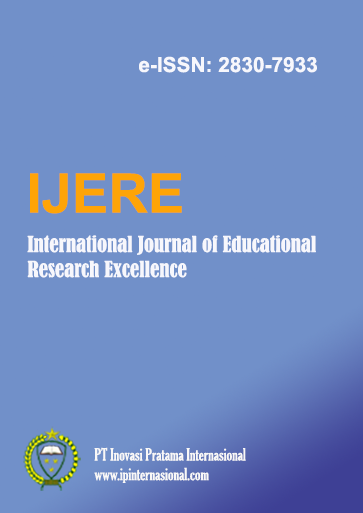The Development of Reading Teaching Material through Phonics Method for Kindergarten Students at DD2 School Medan in 2023/2024
Main Article Content
Abstract
Several factors influence the teaching and learning process. The first is students. They have different interests, abilities, and behaviours, which will affect their achievement in learning English. Motivation is a basic factor in the teaching and learning process in the classroom. Students who are highly motivated will be active, but students who are low motivated will be passive and disturb other students. The Development Model in this study will be conducted to develop the phonics method as a method in teaching reading materials for kindergarten students. To achieve this goal, a research approach is needed that highlights efforts to produce reading teaching strategies. Therefore, in designing the model, researchers used the Research and Development approach by adapting the Borg and Gall model.Based on the result of the research and development carried out, it can concluded that developing reading materials through the phonics method designed by researchers aims to help students read simple sentences in English. The development of reading materials through the phonics method that has been designed by researchers has passed the validation stage by 2 expert validators. The effectiveness of reading material through phonics method for kindergarten students at DD2 School Medan that has been developed by researchers can be seen from the results of the effectiveness test.
Downloads
Article Details

This work is licensed under a Creative Commons Attribution 4.0 International License.
References
Barac, R., Bialystok, E., Castro, D. C., & Sanchez, M. (2014). The cognitive development of young dual language learners: A critical review. Early Childhood Research Quarterly, 29(4), 699–714. https://doi.org/10.1016/j.ecresq.2014.02.003
Dhieni, et al. (2011). Metode Pengembangan Bahasa.
Fridani, L. (2014). Hakikat Perkembangan Bahasa Anak. Metode Pengembangan Bahasa, 1–28.
Gates, L., & Yale, I. (2011). A Logical Letter‐Sound System in Five Phonic Generalizations. The Reading Teacher, 64(5), 330–339. https://doi.org/10.1598/RT.64.5.3
Jamaris, M. (2014). Kesulitan Belajar: Perspektif, Asesmen, dan Penanggulangannya Bagi Anak Usia Dini.
Lana-Peixoto, M. A., & Teixeira, A. L. (2002). Simple phonic tic in multiple sclerosis. Multiple Sclerosis Journal, 8(6), 510–511. https://doi.org/10.1191/1352458502ms829oa
Lloyd, S. (2007). The Phonics Handbook: A Handbook of Teaching Reading, Writing and Spelling.
Mckee, S. (2012). Reading Comprehension, What We Know: A Review of Research 1995 to 2011. Language Testing in Asia, 2(1), 45. https://doi.org/10.1186/2229-0443-2-1-45
Otto, B. (2015). Perkembangan Bahasa Pada Anak Usia Dini: Edisi Ketiga.
Retnomurti, A. B., Hendrawaty, N., & Nurhayati, N. (2019). Strategi Pengenalan Membaca Phonics Method dalam Pengabdian kepada Masyarakat di Jakarta Selatan. JPP IPTEK (Jurnal Pengabdian Dan Penerapan IPTEK), 3(1), 15–24. https://doi.org/10.31284/j.jpp-iptek.2019.v3i1.473
Santrock, J. . (2002). Life Span Development: Jilid 1.
Seefeldt, C., & Wasik, B. A. (2008). Pendidikan anak usia dini: Menyiapkan anak usia tiga, empat, dan lima tahun masuk sekolah.
Suggate, S. P., Schaughency, E. A., & Reese, E. (2013). Children learning to read later catch up to children reading earlier. Early Childhood Research Quarterly, 28(1), 33–48. https://doi.org/10.1016/j.ecresq.2012.04.004
Suminah, et al. (2015). Kurikulum pendidikan anak usia dini apa, mengapa, dan bagaimana.
Westhisi, S. M. (2019). Metode Fonik dalam Pembelajaran Membaca Permulaan Bahasa Inggris Anak Usia Dini. Tunas Siliwangi: Jurnal Program Studi Pendidikan Guru PAUD STKIP Siliwangi Bandung, 5(1), 23-37. https://doi.org/https://doi.org/10.22460/ts.v5i1p29-43.1271.

